Reading Montages: perceptions, dilemmas, edges and resolution.
By Christene Drewe | 27 May 2016
Siganto Foundation Research Fellow Victoria Cooper continues her research of the artists' book & zine collections of the Australian Library of Art. Her passion for montage is evident in her lectures & writing. There is however a question which inevitably arises -what is the difference between montage & collage?
Nomenclature Dilemma: Collage or Montage
In this third blog post I will share the dilemmas of encountering the blurred boundaries associated with the lexicon of these art forms, for example: What is the difference between collage and montage? Does it matter? Are there different “readings” of collage vs montage images that have been reproduced by mechanical or digital means for both wall art, or as encountered in my research, book forms? I will present an Occam’s Razor resolution arising from the considerations that inform my research to provide a path through the complexity of these issues.
Responding to terminology dilemma:
As I progress through the research I am continually confronted with terminology issues and questions regarding the nature of montage and its intersection with collage. The dilemma is with me as a kind of Sisyphean cycle where, after climbing the mountain of wondrous diversity in the Australian Library of Art artists’ book collection; I am drawn back down by the weighty issues of inconsistent terminology.
Many artists, who cut, arrange and glue disparate and/or mixed media elements refer to their work as collage or for computer made images, digital collage. This should be the end of the debate as the etymology of collage is the French word ‘to glue’. But there are others who cut and piece together disparate elements and ‘glue’ and then fuse them within the image and refer to their process as montage (or digital montage for computer images). Also interesting to note is that the origin of the word montage is a French word meaning ‘to mount’. Is there a need to differentiate between these similar practices? Does terminology affect the ‘reading’ of these works? In my art practice I refer to myself as a montage maker, thinker and reader and as such I bring my own perspective to reading visual narratives.
Gracia Haby and Louise Jennison, who prefer to be known as paper artists, make collage works. Their unique state artists’ books and democratic multiples in the form of zines and editions of artists’ books have a place within this discussion.
Haby and Jennison responded to my email question regarding the nature of the digital work in their book, ‘And we stood alone in the silent night’, where they state that: 'Digital collages are made in chorus with unique state pieces. They are all a means of making, with the 'how' of lesser interest to us than the 'why' or 'message'.
In their statement above they suggest that the means of the making is secondary to the final work. Even when the collage has been digitally scanned and then printed it remains, for them, a collage.
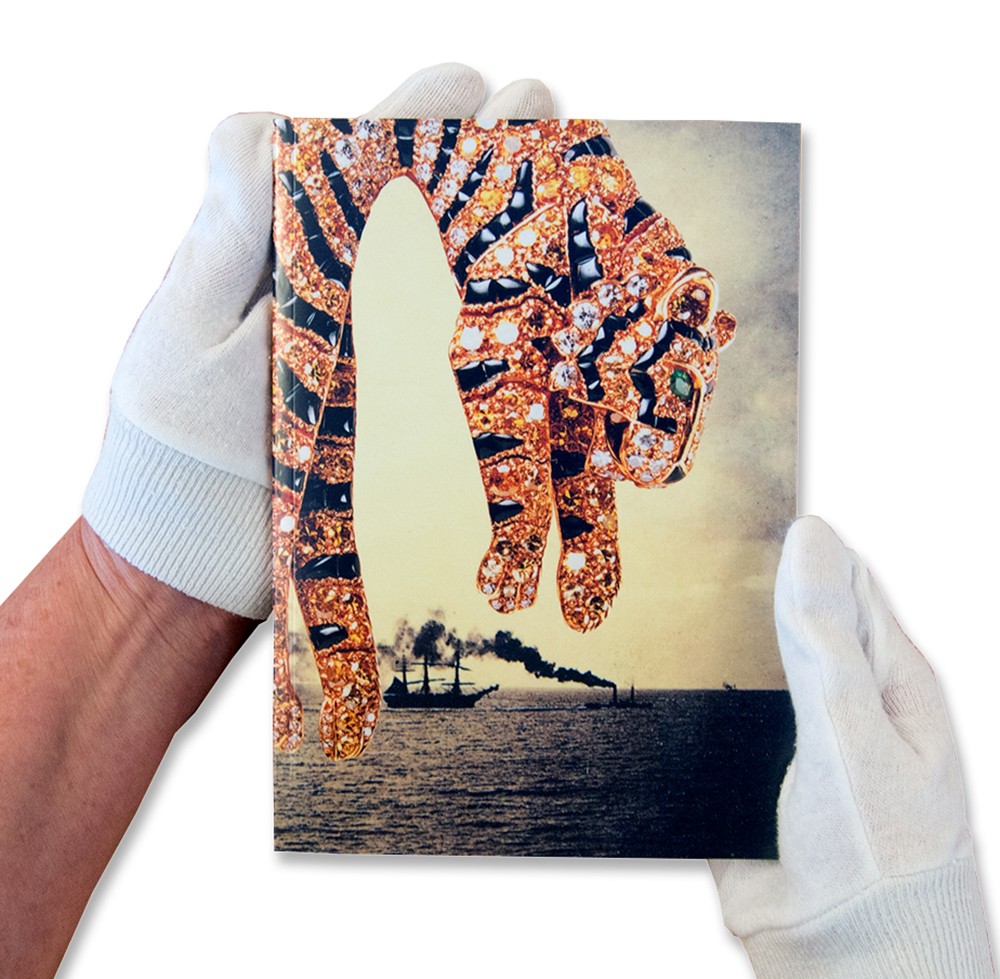
‘And we stood alone in the silent night’
The book, ‘And we stood alone in the silent night’, presents the reader with an enchanted narrative through the composition of images and poetic texts across the pages. Underpinning the reading is the smooth and seamless joins of the elements creating a surreal landscape with a theatre of colourful inhabitants. The compositional elements draw the reader into a kind of Alice in Wonderland experience of reading: where the fused elements are arranged in a mise en page; and the turning page emulates the scenes of a paper movie (i) . The small size text comes through the reading as a poetic aside to underscore the scene.
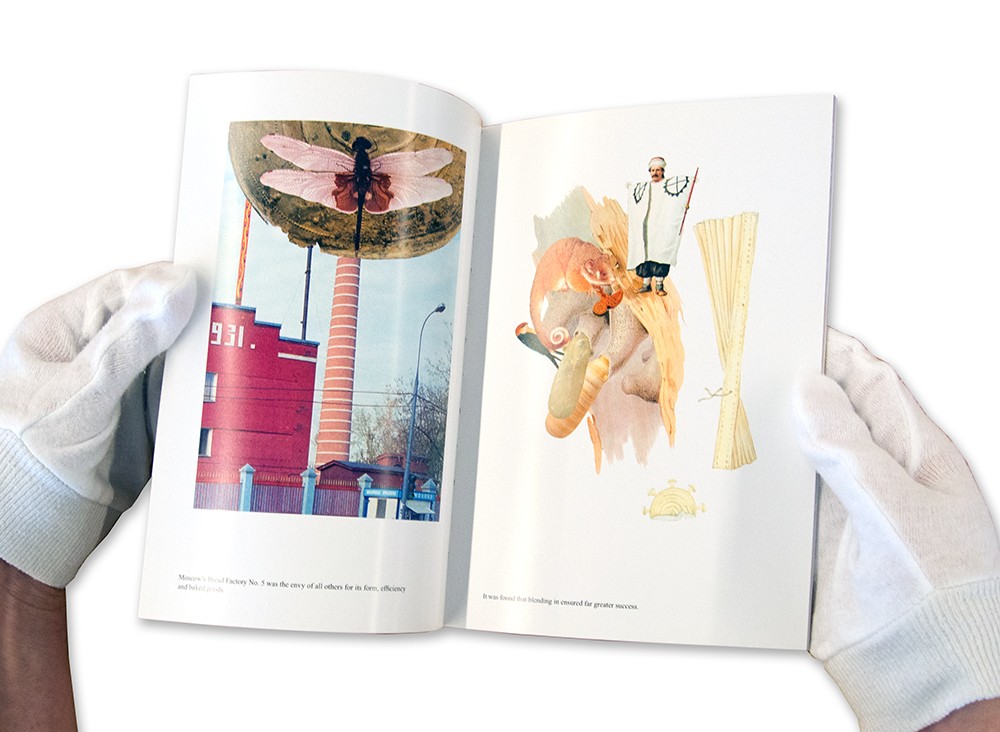
‘And we stood alone in the silent night’
Haby and Jennison’s careful cutting and pasting of added elements over or alongside the original image distinguish their broader collage work. Again, in these works the silent edges between these interventions and the original image provide uninterrupted reading. Importantly as this transition or interval between the elements goes unnoticed the added element ultimately colonize the interior space and time of the original image.
So far in my research, I have not found many artists that tear and roughly cut their elements intentionally leaving these edges in the final montage for the reader to interpret. One example however is Lorelei Clark’s work, 'Brisbane: River City'.
Although the elements are fused by digital reproduction, their roughly torn or cut edges seem to separate the elements so that the reading is disturbed much like a jump-cut (ii) edit in a film.
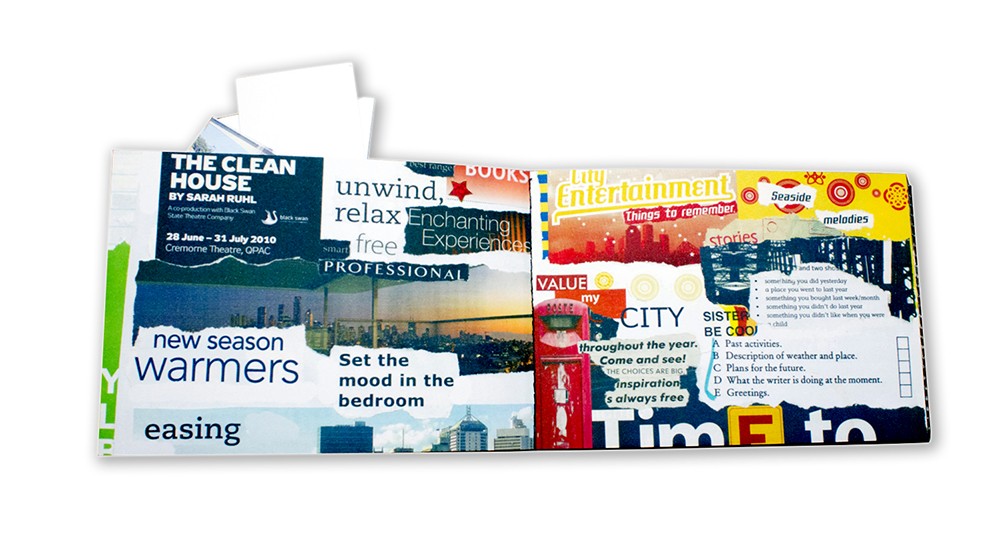
The elements combined in this way demand separate attention and focus on individual parts of the narrative or issue presented. As the source material may have been glossy magazines or pictorial publications, these edges could represent a critique or even an attack on social issues that affect the human condition. In many ways the reading is unsettling, rather like the political montages of Peter Lyssiotis, they shout back at the reader.
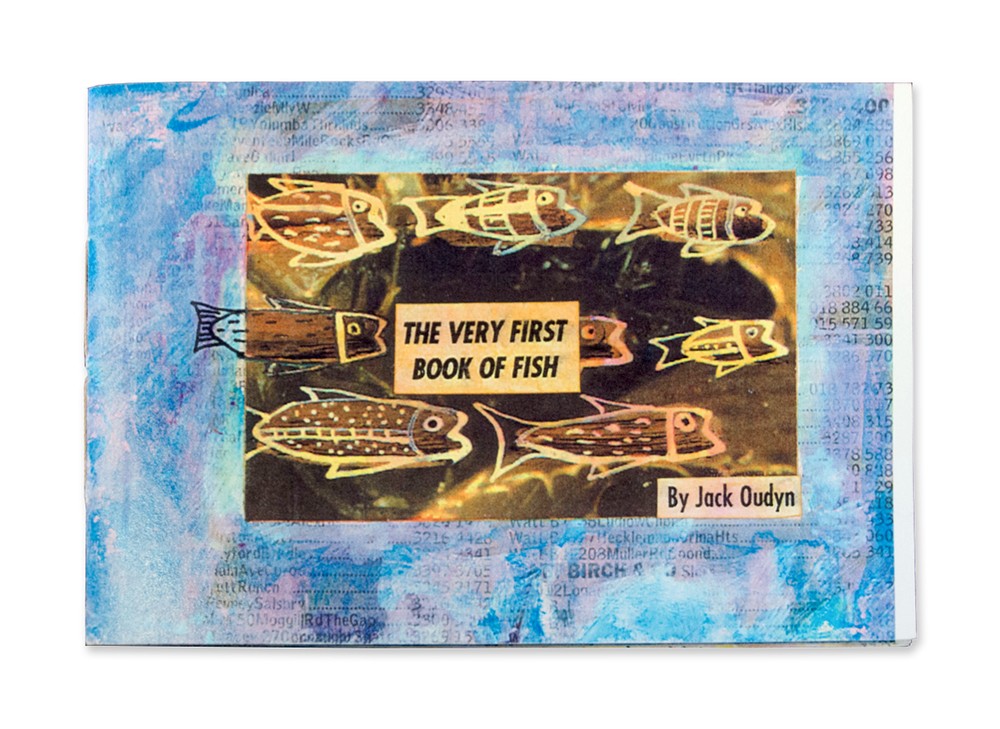
Another example of the rough cut collage can be found in Jack Oudyn’s Book of Fish series of small books, where the original collage or paste-up can be seen in the ALA collection along with the small zine like productions. Rather than attached to the surface, the reproduction of these collages fuses the elements into the page and transforms the reading of the text and images. In these little books, the elements are submerged within the narrative and seem to float around like the flotsam and jetsam of everyday life.
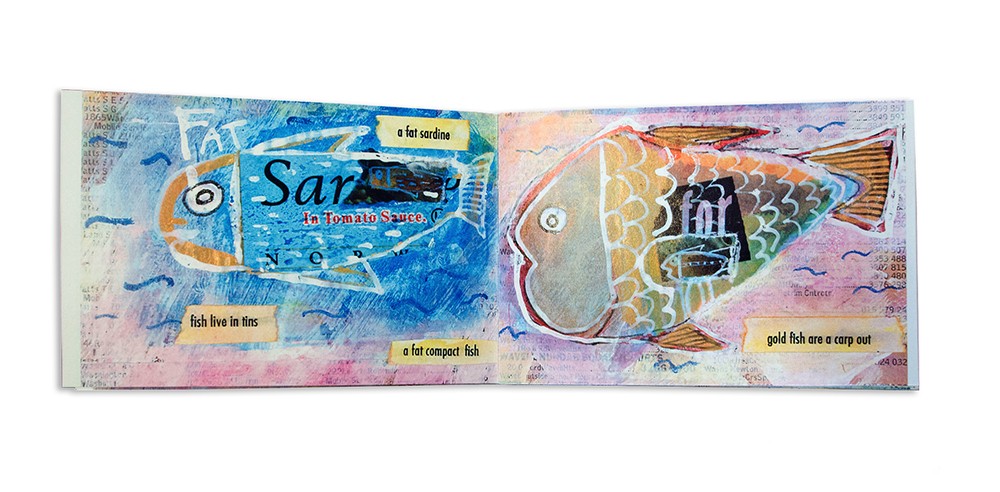
Jack Oudyn 'The very first book of fish'.
My resolve:
For the purpose of this research, I have decided to take account of how the artist defines their work as stated in the Library catalogue. As a researcher I am reliant on the information supplied by the artist, either in the form of an artist’s statement or catalogue information. This information allows a deep engagement with the work that ultimately enriches the reading experience for the researcher. Many may consider that too much information may reduce the potential for the book to be reimagined, but for readers like myself there are many ‘readings’ of an artists’ book. As social scientist, Pierre Bourdieu suggests that an artwork is:
'in fact made not twice, but hundreds of times, thousands of times by all those who have an interest in it, who find a material or symbolic profit in reading it, classifying it, decoding it, commenting on it, reproducing it, criticizing it, combating it, knowing it, possessing it.' (iii)
As mentioned earlier in this blog I refer to my work as montage, and align my methodology and inspiration with that of film and the pioneers of montage and page design from the early 20th century. In this research I have found similarities in the ‘reading’ of collages that have been either created or reproduced through mechanical or digital processes with the images created as montages. As I strive to engage with the many new ways of reading that each artist presents, any background information can take me into new spaces and places, each time I read the same book.
So rather than questioning the terminology, either a collage or montage, I am more informed by the way elements are grafted or combined; their arrangement on the page; the typography and page design. When the elements such as type, photographs, painting, drawing, found objects etc have been fused within the space of the page of the book by photomechanical, digital or another printmaking process, I will read these as a montage. As such, in the research I will consider the following:
• whether I am seduced by nature of the smooth transition and the interval between elements is subliminal or if the torn edge focuses my attention;
• whether the adjacency of the elements is disturbing or attacking my attempts to flow smoothly;
• whether the transition has been digitally achieved or by hand if the information is available.
The nature of the edges of the combined visual elements within the composition is a profound aspect to reading these visual books. So rather than questioning the terminology, whether a collage or montage, I will continue in my ‘montage readings’ informed by the narratives contained within and between grafted edges.
Victoria Cooper
i. Lou Stoumen is the author of visual books including 'Can't Argue With Sunrise: A Paper Movie' (1975)
ii. Film makers Jean-Luke Godard and Sergei Eisenstein championed the use of discontinuity devices such as jump cuts in scenes to disrupt the flow of the cinematic narrative and create the illusion of moving through time and space. This was intended to engage the viewer proactively to think about the issues surrounding the scene.
iii. Bourdieu, Pierre. 'The Rules of Art: Genesis and Structure of the Literary Field'. Translated by Susan Emanuel. Stanford University Press, 1996. Editions du Seuil 1992. Page 171.
Comments
Your email address will not be published.
We welcome relevant, respectful comments.